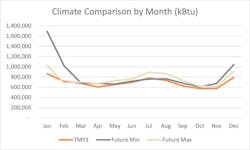Climate modeling for a resilient business and future
We often talk about sustainability strategies that help to minimize environmental impact and slow the effects of climate change. Designing for resilience is equally important now that the earth’s temperature has started to rise, and abnormal climate events are becoming the norm. This post addresses how climate modeling can inform design strategies to respond to climate change, rather than design strategies to prevent climate change.
Developers evaluate a multitude of data when managing an investment, and one of the greatest variables facing a real estate project is the impacts of climate change.
Energy models typically rely on historic data to anticipate predicted energy performance and energy usage. And energy audits analyze historical data to help estimate future energy savings. But that historic data is giving way to forward-looking climate-related trend lines around increased droughts and heatwaves, changes in precipitation patterns including heavy downpours, average temperature rise, severity of hurricanes and their locations, and of course sea level rise. All these issues impact real estate – and proactive developers, owners, and insurance providers are making decisions accordingly.
The difference between climate and weather is well documented. The simplest definition, and the one I like is that climate is what you expect, and weather is what you get.
Forward-thinking real estate developers are including climate modeling in their feasibility and planning phases. What is an example of a climate model?
Climate models follow a similar structure to weather models, except they are broader and cover a longer time span. While a weather forecast might predict how much rain will fall in the next seven days, a climate model will predict changes in rainfall over the next several decades.
The data considered in climate models is broader as well and may include more atmospheric, oceanic, and land processes than weather models do—such as ocean circulation and melting glaciers. Climate models are typically generated from mathematical equations that use thousands of data points to simulate the transfer of energy and water that takes place in climate systems.
All the issues contributing to climate change and extreme climate events can be difficult to wrap your head around when making decisions about a real estate asset. Climate models help with those decisions by providing possible scenarios based on available data.
To support developers that are interested in implementing future-informed climate models in their program strategy, let’s start by looking at a comparison of modeled results based on historical weather data versus future predicted climate data.
To help analyze temperature extremes, we modeled a sample building against a typical Meteorological Year (TMY3) weather file and compared the building at TMY3 to a future prediction climate file.
The analysis illustrates there is a big jump in overall energy required, which is to be expected, and energy use is not the only thing increasing. Because buildings and systems are designed for our current climate, they may not meet future climate conditions. Therefore, hours outside thermal comfort ranges (unmet hours) are increasing. The biggest delta in energy use occurs in the summer and winter when conditions are most extreme, leaving systems potentially undersized and future occupants uncomfortable. Consider this graph which shows the increasing unmet hours for the future climate scenarios as EUI is also increasing.
A solution might be to oversize the systems so they are ready for all future conditions, but this will only increase energy consumption which further contributes to climate change. The better solution is to target passive strategies that will help maintain building comfort in extreme weather events and in power outages.
Our models show that passive strategies that target internal loads are the most effective at tackling both energy use and unmet hours. None of this is surprising, and most of it is common sense. But when we can quantify the common sense of passive strategies, it becomes simpler to propose and enforce.
By designing with passive strategies, you are helping reduce overall energy impact and carbon emissions from the building, and also contributing to occupant comfort in the event of extreme weather conditions, which are becoming more common as climate change accelerates, While designing to curb climate change is imperative, we also need to design for climate change now.
To maximize asset performance in the face of climate change you should still include prevention tactics like net-zero energy and net-zero carbon, and smart developers also prepare their assets to perform as the climate brings more severe and unpredictable weather.


